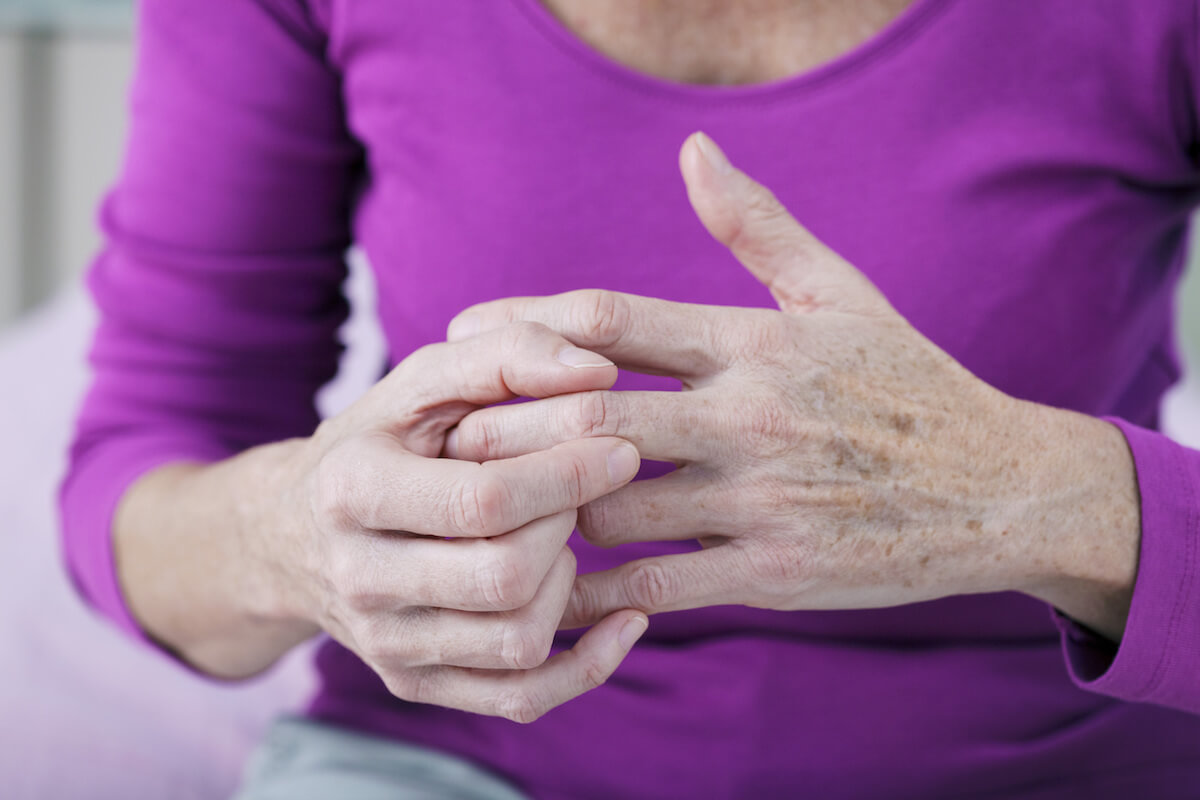4 Tips on How to Manage Arthritis

Arthritis is an umbrella term that is used to describe joint pain or joint disease that causes inflammation, pain, and stiffness of the affected joint(s). There are over 100 different types of arthritis, and roughly 54 million adults in the United States have been diagnosed with a form of the condition.
Depending on the severity of the diagnosis, there are certain habits and tips that can alleviate some of the pain and symptoms associated with arthritis. It’s important to note that, before making any lifestyle changes, you or your loved one should consult with a healthcare professional to ensure a treatment option is the best solution.
1. Weight & Exercise Management
Excess body weight can place unnecessary stress on joints – especially those affected by arthritis. While many assume exercise would have a negative impact on joints, when done appropriately, physical activity can help ease the pain of arthritis and boost energy levels. Managing arthritis with exercise is all based on a person’s body, comfort level, and physician recommendations.
Simple exercises, such as yoga, stretching, water aerobics, and walking are low-impact workouts that may help you or your loved one manage the symptoms of arthritis. And one of the best parts about committing to an exercise routine is that there are activities out there for everyone. One example that is gaining in popularity is Nordic walking, which involves the use of ski poles outfitted with a metal spike for use on dirt or snow and a rubber pad for use on asphalt and sidewalk.
Because you are using poles while you exercise, Nordic walking has been shown to deliver a more complete workout. Study participants burned 20% more calories and experienced greater oxygen intake and heart health. At the same time, the poles provide greater stability and prevent injury for those with arthritis.
Most entry-level poles start at approximately $50, making them an affordable option for someone looking for a new type of safe, low-impact exercise.
2. Dietary Changes
Surprisingly, changing your diet can also help manage the pain and symptoms of arthritis. There are many different nutritious options that can positively impact your arthritis management. Below are a few foods that have a particularly significant impact on arthritis as well as your overall health and wellness.
Fish – Fish, especially fatty fish, are high in omega-3 acids, which have been shown to have properties that help reduce inflammation. Certain types of fish are also rich in vitamin D, which may also help reduce the symptoms of arthritis.
Soy – If you are vegetarian or vegan – but still want to reap the benefits of omega-3 fatty acids – then soybeans are the best option for you. Recipes that feature edamame or tofu will help you maximize the impact of omega-3 acids without consuming animal products.
Beans – Red beans and kidney beans are rich in protein as well as essential nutrients like folic acid, magnesium, and potassium. This makes them a great option for building lean muscle and improving heart health. In addition, including beans as a regular part of your diet can help combat the effects of rheumatoid arthritis.
Berries – High in antioxidants, berries may be a key to helping reduce inflammation. One study found that participants who ate at least two servings a week of strawberries were 14% less likely to experience swelling. In a different study, the properties of antioxidants (quercetin and rutin) decreased the symptoms of arthritis in test subjects.
Spinach – Regarded as one of the healthiest vegetables, spinach is rich in many nutrients, including antioxidants, iron, protein, and minerals. Research suggests that consuming spinach can help manage arthritis and help combat other diseases.
At HarborChase Senior Living, we recognize how important a healthy diet can be for our residents and guests. That is why we are committed to serving fresh, locally sourced, nutrient-rich meals and snacks throughout our HarborChase communities. With dining options that include fresh-made sandwiches, wholesome casual cuisine, and fine dining menus prepared by world-class chefs, we serve meals every day that are both delicious and healthy.
When it comes to making changes to your diet, it is important to conduct thorough research and consult with a healthcare professional, as there are additional foods that are proven to help reduce some of the symptoms of arthritis.
3. Heat & Cold Therapy
The heat side of this therapy can help increase blood flow while reducing stiffness and pain in the affected joints. Taking a bath with warm (92 to 100 degrees Fahrenheit) water can help – but should be avoided if your joints are swollen or bruised. For this treatment to be effective, be sure the water is at a consistent temperature and that you remain in the water for an extended period. The heat side of the therapy is also perfect for pre-workout.
If you have access to a heated pool, water exercise is the perfect way to maximize the combined benefits of heat therapy and a workout routine. And the best part is that the benefits last long after you have stepped out of the pool. Many of our HarborChase Senior Living communities offer water aerobics classes, which reduce the effects of gravity and provide participants with a smooth, comfortable experience – even if they have limited mobility.
Research shows that people who participate in water aerobics 2-3 times each week experience greater range of motion and reduced soreness throughout the week – a clear benefit to spending some time in the water.
Even if you cannot make it to the pool during the week, you can still benefit from the effects of a hot water compress. It is easy to create – soak a washcloth, place it in a seal-proof and microwave-safe bag, and heat it in the microwave. Then set the hot compress on the sore area (back, hip, knees, etc.) while you are relaxing or working at home.
By using a hot water compress for 20 minutes each day, you can loosen your stiff muscles and joints and reduce the pain and discomfort you would otherwise feel.
Use the cold side of this therapy to help reduce swelling and tender joints. Wrapping an ice pack around a swollen joint can reduce inflammation, reduce pain, and prevent muscle spasms. This side of therapy is perfect for post-workout, as it can help reduce potential inflammation caused by strain and stress on affected joints.
Doctors agree that a mixture of both heat and cold therapy can help in reducing symptoms, but it is important to note your parent or loved one’s comfort level and accessibility.
4. Massage Therapy
According to the Arthritis Foundation, massage therapy comes with a variety of benefits that can help reduce arthritis symptoms. When managing arthritis, massage therapy, whether administered by yourself or a professional, can help reduce pain, stiffness, improve the overall function of the joints, and increase range of motion.
Massage therapy, in general, can help relieve stress, anxiety, and has been shown to help improve the quality of sleep, a common issue among those who have arthritis. To get the best treatment for you or a loved one, speak to a healthcare professional, and ask for a reference (as opposed to going to a massage therapist who is unaware of preexisting conditions).
As the Arthritis Foundation points out, you must alert your massage therapist if you are experiencing any pain or discomfort during your session. Although research indicates that massage therapy can alleviate the impact of many different types of arthritis, including knee, hand, and back pain, people with certain conditions should exercise caution or avoid massage therapy. High-risk conditions include damage or eroded joints, susceptibility to inflammation, severe osteoporosis, high blood pressure, and varicose veins.
Knowing how to manage arthritis is all about listening to one’s body. One of the best methods for healing is R.I.C.E.:
Rest
If you feel pain or discomfort, especially during exercise, it is important to stop what you are doing. There is a difference between typical muscle soreness that follows exercise and the more acute, severe joint pain that can become debilitating if not handled correctly. When in doubt, rest.
Ice
Using ice is the best way to reduce swelling and inflammation in affected joints. Part of managing arthritis is addressing the swelling and discomfort that often occurs, and 20 minutes of ice compress is a great way to do that.
Compression
When it comes to helping your aching joints and muscles, compression treatment is a step that is often overlooked. You can create compression on your own by using towels or a weighted blanket, or you can investigate purchasing compression sleeves for your legs, arms, ankles, or elbows. There are also arthritis gloves available for dealing with hand inflammation and pain.
Elevation
If you find that you are struggling to gain relief, especially when arthritis affects your lower body, try elevating your legs with a cushion or pillow. Elevation helps to stimulate blood flow and regulate circulation to your legs and feet, which can go a long way toward helping you manage arthritis.
Arthritis is common among older adults and can lead to pain and discomfort. Fortunately, there are many ways you can manage arthritis to increase mobility, reduce pain, and enjoy a more comfortable and active lifestyle. However, before trying any specific therapy, be sure to consult with a healthcare professional to help ensure success and minimize the risk of injury.
If you found this information useful and would like more information regarding senior health, we invite you to explore our HarborChase blog.
Tags: Health Habits
December 8, 2025
This winter, prioritize your well-being with our senior winter wellness tips to promote comfort, connection, and vitality.
December 1, 2025
Discover how our dedicated memory care communities foster meaningful moments for residents and their families during the holidays.

